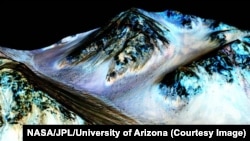NASA scientists have found strong evidence of salt water streams on Mars, at least during the red planet's summer, the space agency announced Monday.
The lines of "hydrated" salt minerals found would require water for their creation, and where there’s liquid water, there could be life, even if it's in microbial form.
"Today we are revolutionizing our understanding of this planet," Jim Green, director of planetary science at NASA Headquarters, said during a news conference releasing the findings.
Amid speculation before the announcement, Doug McCuistion, the former head of NASA’s Mars program, told the Boston Herald, “If they are announcing that they have found easily accessible, freely flowing liquid water under the surface, which is one of the theories we have been hearing for years and years, that has massive implications both for the potential for life on that planet and sustainability of humans."
Taking part in the conference were: Green; Michael Meyer, lead scientist for the Mars Exploration Program at NASA Headquarters; Lujendra Ojha of the Georgia Institute of Technology in Atlanta; Mary Beth Wilhelm of NASA's Ames Research Center in Moffett Field, California and the Georgia Institute of Technology; and Alfred McEwen, principal investigator for the High Resolution Imaging Science Experiment (HiRISE) at the University of Arizona in Tucson.
NASA has found evidence of water on Mars in the past. In March, NASA said there was once more water on Mars than in Earth's Arctic Ocean.
NASA researchers wrote in the journal Science that they compared the ratio of two different types of water found in the Martian atmosphere to the ratio of those waters trapped in a Martian meteorite dating back 4.5 billion years.
They say more than 4 billion years ago, Mars was covered with water 137 meters deep and that nearly all of it has since evaporated into space.












